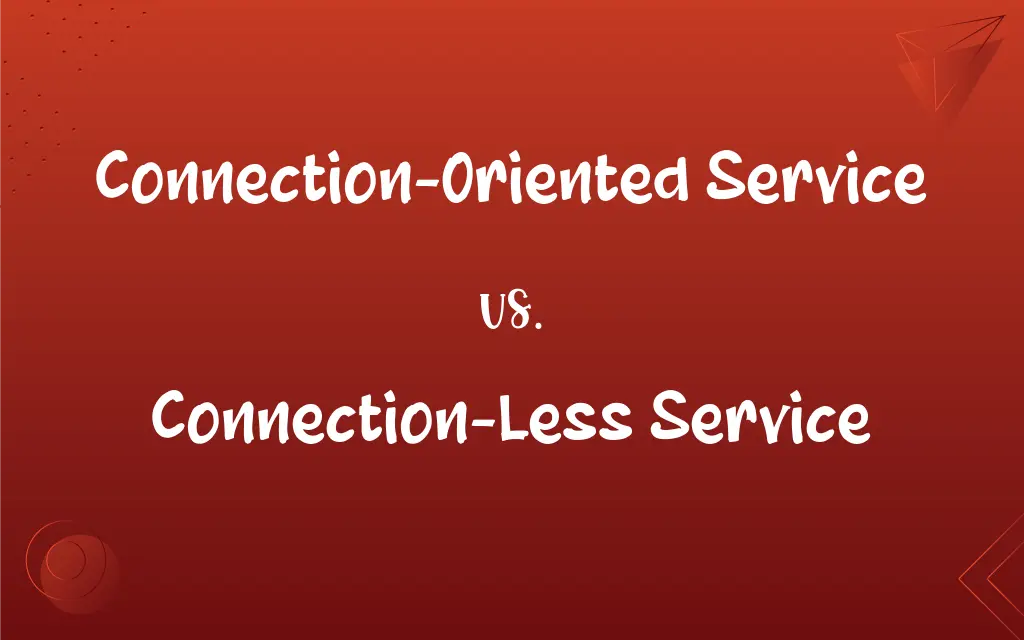Connection-Oriented Service vs. Connection-Less Service: What's the Difference?
Edited by Aimie Carlson || By Janet White || Published on February 28, 2024
Connection-oriented service establishes a dedicated connection before data transfer, ensuring reliability; connection-less service sends data without pre-established paths, offering speed and flexibility.

Key Differences
Connection-oriented services require the establishment of a session or connection between endpoints before any data transfer. This approach ensures a reliable and sequenced flow of data. On the other hand, connection-less services send data packets independently without a dedicated path or session, favoring speed and flexibility over reliability.
In a connection-oriented service, data integrity and order are maintained as the connection manages the sequence and acknowledges receipt. Conversely, connection-less services do not inherently provide mechanisms for data sequencing or integrity, leaving such tasks to higher layers if needed.
Connection-oriented services are akin to making a phone call, where a dedicated line is set up for the duration of the call. In contrast, connection-less services resemble sending individual postcards, where each postcard travels independently without a guaranteed order or delivery confirmation.
The overhead associated with establishing and maintaining a connection in connection-oriented services can lead to delays, making it less suitable for quick, transient data exchanges. Connection-less services, with their minimal setup, are more efficient for small or sporadic data transfers.
Connection-oriented services are typically used where reliability and data integrity are crucial, like file transfers or video streaming. Connection-less services are common in scenarios where quick delivery and network efficiency are prioritized, such as in basic Internet browsing or DNS queries.
ADVERTISEMENT
Comparison Chart
Connection Establishment
Requires pre-established connection
No connection setup required
Data Transfer Reliability
High, with guaranteed order and delivery
Variable, with no inherent order or guarantee
Overhead and Complexity
Higher due to connection management
Lower, with minimal overhead
Suitability
Ideal for reliable data transfer like file streaming
Better for quick and transient data exchanges
Examples
Telephone calls, TCP (Transmission Control Protocol)
Sending emails, UDP (User Datagram Protocol)
ADVERTISEMENT
Connection-Oriented Service and Connection-Less Service Definitions
Connection-Oriented Service
Involves connection setup, maintenance, and termination.
Sending files over FTP is a process managed by a connection-oriented service.
Connection-Less Service
Does not guarantee data order or integrity.
Using a simple messaging app for text messages can be an example of a connection-less service.
Connection-Oriented Service
Often uses protocols like TCP for data transmission.
Browsing a website securely with HTTPS is facilitated by a connection-oriented service.
Connection-Less Service
Sends data without establishing a dedicated connection.
Sending a quick email utilizes a connection-less service.
Connection-Oriented Service
A service where a dedicated connection is established before data transfer.
Making a VoIP call uses a connection-oriented service for stable communication.
Connection-Less Service
Offers speed and efficiency for data transfer.
Browsing different websites often involves a connection-less service for quick loading.
Connection-Oriented Service
Ensures reliable and sequential data delivery.
Streaming a movie online typically employs a connection-oriented service.
Connection-Less Service
Suitable for applications where speed is prioritized over reliability.
Streaming live sports where real-time delivery is crucial might use a connection-less service.
Connection-Oriented Service
Suitable for applications where data integrity is critical.
Online banking transactions use a connection-oriented service for secure data transfer.
Connection-Less Service
Often employs protocols like UDP in communications.
Playing online games often uses a connection-less service for faster data exchange.
FAQs
What makes connection-less service fast?
It skips the overhead of establishing and maintaining a connection.
Can connection-oriented services handle high-speed data transfers?
Yes, but with more overhead compared to connection-less services.
What is a connection-oriented service?
A service that establishes a dedicated connection before transferring data.
Are connection-less services unreliable?
They're less reliable than connection-oriented services but can be efficient for certain applications.
Is connection setup always time-consuming in connection-oriented services?
It can be, especially in high-latency networks.
Why is connection-oriented service considered reliable?
It ensures ordered, confirmed delivery of data packets.
Are connection-less services suitable for streaming video?
Typically not, as they lack the reliability needed for continuous data streams.
What is a connection-less service?
A service that sends data without setting up a dedicated path.
Do connection-less services provide data integrity checks?
No, they generally lack built-in mechanisms for integrity checks.
How do connection-oriented services handle congestion?
They often have built-in mechanisms to adjust data flow and avoid congestion.
Do connection-less services adjust to network congestion?
They typically do not have mechanisms to handle congestion effectively.
Can a service switch between connection-oriented and connection-less modes?
Some protocols and services can adapt based on requirements.
What is an example of a connection-oriented protocol?
TCP (Transmission Control Protocol) is a common example.
What is an example of a connection-less protocol?
UDP (User Datagram Protocol) is widely used.
Can connection-oriented services be used for casual browsing?
Yes, but they may add unnecessary overhead for simple tasks.
How does a connection-oriented service handle data loss?
It typically retransmits lost packets, ensuring complete data delivery.
Do connection-less services retransmit lost data?
No, they usually do not have mechanisms for retransmission.
Is TCP/IP connection-oriented or connection-less?
TCP is connection-oriented, while IP can be both, depending on the context.
Are all Internet services connection-oriented?
No, many services, like email, can use connection-less protocols.
Is one service type better than the other?
It depends on the application's needs for speed, reliability, and data integrity.
About Author
Written by
Janet WhiteJanet White has been an esteemed writer and blogger for Difference Wiki. Holding a Master's degree in Science and Medical Journalism from the prestigious Boston University, she has consistently demonstrated her expertise and passion for her field. When she's not immersed in her work, Janet relishes her time exercising, delving into a good book, and cherishing moments with friends and family.
Edited by
Aimie CarlsonAimie Carlson, holding a master's degree in English literature, is a fervent English language enthusiast. She lends her writing talents to Difference Wiki, a prominent website that specializes in comparisons, offering readers insightful analyses that both captivate and inform.































































